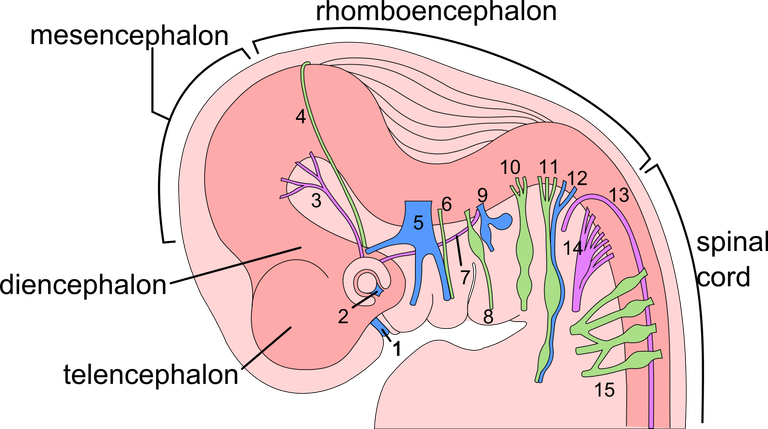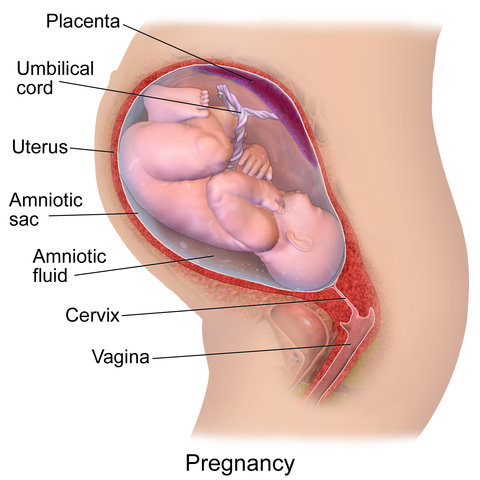Out on the surface of the little embryo, a tiny crease appears. Gradually it folds itself inward and forms three hollow chambers, with a short tube thrust out on one end. Believe it or not, this is the beginning of the spinal cord and human brain! It all looks so simple at this point. One could hardly imagine the enormous possibilities that lie ahead of the rapidly developing human organism.

A diagram showing the brain and major nerves of a 6 week old human fetus via wikimedia commons

Still the wonderful process of growth goes on. Nerves grow out to the tissues and organs long before they are actually needed, linking together the whole organism with an elaborate system of living electric cables. Meanwhile, a strong framework of tough tissues is laid down in cartilage or gristle, later developing into powerful bones and joints. Near-by muscles begin to attach themselves by tendons to the bones, ready for active days ahead.


Pixabay CC0
Unlike the birds, reptiles, insects, and other simpler forms of animal life, the human baby, in common with higher animals, must depend upon his mother for food, shelter, and protection. He must grow inside her body for a definite period until he is ready to live in his own. He does this by means of a special Organ called the Placenta, or “afterbirth.”
The placenta develops from those same folding membranes of which the baby himself is formed. The placenta is shaped somewhat like a mushroom, except that where the stem should be, there is a long cord. This is the Umbilical Cord. It contains blood-vessels through which the baby receives food and oxygen from the mother. The other end of the umbilical cord is attached to the middle of the baby’s abdomen. After the baby is born this cord is carefully tied and cut, and the placenta is thrown away. Its work is finished. The short end of the umbilical cord, the part attached to the baby, eventually dries up and falls off, leaving a depression in the middle of the abdomen called the navel, or umbilicus. The umbilical cord is the only real connection between the unborn baby and the mother.
Early in its development, the placenta sinks tiny “fingers” or tentacles down into the soft, inner lining of the mother. These two separate blood streams have no actual connection with each other., but the membranes that divide them are so thin that food materials, oxygen, and waste products can readily pass across. So the baby draws his food and oxygen from the mothers blood stream, while at the same time, waste products from his body are picked up by the mother’s blood stream and carried to her lungs and kidneys where they are removed.


Blausen.com staff (2014). "Medical gallery of Blausen Medical 2014" via wikipedia.org
Along with the placenta, another interesting structure is formed. During the early months of pregnancy, those same folding membranes form themselves into a strong envelope that completely covers the baby. This envelope, or Amniotic Sac, is filled with a clear fluid that protects the baby from injury and yet allows him to move freely within the fluid. The amniotic sac is often referred to as “the bag of waters.” The fluid it contains is mildly antiseptic, thus protecting the baby from germs. Normally the bag of waters ruptures just before birth, opening the way for the baby, and making the process of birth that much easier.

This is a brief picture of how a baby develops in the uterus or womb. The whole astounding process takes place with perfect ease and in most cases, without any serious complications, provided the mother is in reasonably good health. Every step leads on to the next, all in perfect order, until in the end, we see another human being made in the image of the Divine.
Thanks for reading
@Scarletmedia

Posted from myAirClinic Healthcare App. Download Android Version from PLAYSTORE!
As a follower of @followforupvotes this post has been randomly selected and upvoted! Enjoy your upvote and have a great day!
Hello! I find your post valuable for the wafrica community! Thanks for the great post! We encourage and support quality contents and projects from the West African region.
Do you have a suggestion, concern or want to appear as a guest author on WAfrica, join our discord server and discuss with a member of our curation team.
Don't forget to join us every Sunday by 20:30GMT for our Sunday WAFRO party on our discord channel. Thank you.